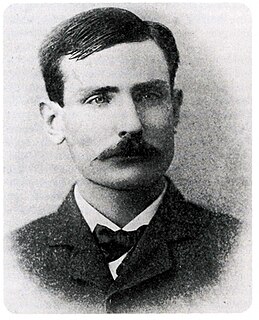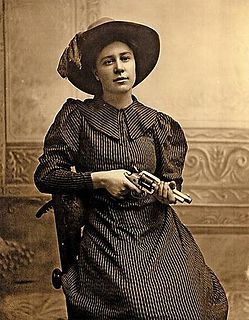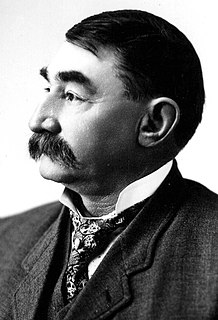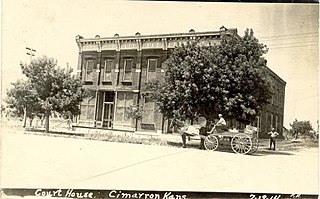
Gray County is a county located in the U.S. state of Kansas. As of the 2010 census, the county population was 6,006. Its county seat and most populous city is Cimarron.

Cimarron is a city in and the county seat of Gray County, Kansas, United States. As of the 2010 census, the city population was 2,184.

John Henry "Doc" Holliday was an American gambler, gunfighter, and dentist. A close friend and associate of lawman Wyatt Earp, Holliday is best known for his role in the events leading up to and following the Gunfight at the O.K. Corral. He developed a reputation as having killed more than a dozen men in various altercations, but modern researchers have concluded that, contrary to popular myth-making, Holliday killed only one to three men. Holliday's colorful life and character have been depicted in many books and portrayed by well-known actors in numerous movies and television series.

The Wild Bunch, also known as the Doolin–Dalton Gang, or the Oklahombres, were a gang of American outlaws based in the Indian Territory in the late 19th and early 20th centuries. They were active in Kansas, Missouri, Arkansas, and Oklahoma Territory during the 1890s—robbing banks and stores, holding up trains, and killing lawmen. They were also known as The Oklahoma Long Riders because of the long dusters that they wore.

Gunslinger and gunfighter are words used historically to refer to people in the American Old West who had gained a reputation of being dangerous with a gun and had participated in gunfights and shootouts. Gunman was a more common term used for these individuals in the 19th and early 20th century. Today, the term "gunslinger" is more or less used to denote someone who is quick on the draw with a pistol, but can also refer to riflemen and shotgun messengers. The gunfighter is also one of the most popular characters in the Western genre and has appeared in associated films, video games, and literature.

Bartholemew William Barclay "Bat" Masterson was a U.S. Army scout, lawman, professional gambler, and journalist known for his exploits in the 19th and early 20th-century American Old West. He was born to a working-class Irish family in Quebec, but he moved to the Western frontier as a young man and quickly distinguished himself as a buffalo hunter, civilian scout, and Indian fighter on the Great Plains. He later earned fame as a gunfighter and sheriff in Dodge City, Kansas, during which time he was involved in several notable shootouts.

Robert A. Clay Allison was a cattle rancher, cattle broker, and sometimes gunfighter of the American Old West. He fought for the Confederacy in the Civil War. Allison had a reputation for violence, having survived several one-on-one knife and gunfights, as well as being implicated in a number of vigilante jail break-ins and lynchings. A drunken Allison once rode his horse through town nearly naked—wearing only his gunbelt. Later most reports stated that he was not only dangerous to others but himself, accidentally shooting himself in the foot.

William "Bill" Doolin was an American bandit outlaw and founder of the Wild Bunch, sometimes known as the Doolin-Dalton Gang. Like the earlier Dalton Gang alone, it specialized in robbing banks, trains, and stagecoaches in Arkansas, Kansas, Indiana and Oklahoma during the 1890s.

Luke L. Short was an American Old West gunfighter, cowboy, U.S. Army scout, dispatch rider, gambler, boxing promoter and saloon owner. He survived numerous gunfights, the most famous of which were against Charlie Storms in Tombstone, Arizona Territory and against Jim Courtright in Fort Worth, Texas. Short had business interests in three of the best known saloons in the Old West: the Oriental in Tombstone, the Long Branch Saloon in Dodge City, and the White Elephant in Fort Worth.

William Matthew Tilghman Jr. was a career lawman, gunfighter, and politician in Kansas and Oklahoma during the late 19th century. Tilghman was a Dodge City city marshal in the early 1880s and played a role in the Kansas County Seat Wars. In 1889 he moved to Oklahoma where he acquired several properties during a series of land rushes. While serving as a Deputy U.S. Marshal in Oklahoma, he gained recognition for capturing the notorious outlaw Bill Doolin and helping to track and kill the other members of Doolin's gang, which made him famous as one of Oklahoma's "Three Guardsmen".

James Patrick "Jim" Masterson, was a lawman of the American West and a younger brother of gunfighters and lawmen Bat Masterson and Ed Masterson.
The Gunfight at Hide Park, or Newton Massacre, was the name given to an Old West gunfight that occurred on August 19, 1871, in Newton, Kansas, United States. It was well publicised at the time, but since has received little historical attention, despite it producing a higher body count than the Gunfight at the O.K. Corral and the Four Dead in Five Seconds Gunfight of 1881. Unlike most other well-known gunfights of the Old West, it involved no notable or well known gunfighters, nor did it propel any of its participants into any degree of fame. Its legend has grown, however, because one of the participants simply walked away from the scene, never to be seen again.

Rose Elizabeth Dunn also known as Rose of Cimarron and later Rose of the Cimarron, was best known for her good looks and for her romantic involvement with outlaw George "Bittercreek" Newcomb when she was a teenager during the closing years of the Old West.

The Battle of Ingalls was a gunfight on September 1, 1893 between United States Marshals and the Doolin-Dalton Gang, during the closing years of the Old West era, in Ingalls, Oklahoma. The Doolin-Dalton Gang had been involved in a number of train robberies and bank robberies, beginning around 1891. They had found a safe haven in the town of Ingalls, which unwittingly harbored many outlaws during that period. On September 1, 1893, a posse was organized by the new United States Marshal, Evett Dumas "E.D." Nix, which entered the outlaw town of Ingalls with the intent to capture the gang. The lawmen were engaged in a gunbattle in which three of the fourteen lawmen carrying Deputy Marshals' commissions would die as a result of the battle.
Frank Loving, sometimes called "Cockeyed" Frank Loving was an Old West gambler and gunman. He was involved in two well-publicized shootouts of the day.
Abraham G. Graham, known by the alias "Shotgun" John Collins, was a little-known though well-associated gunfighter and outlaw of the American Old West.

Benjamin Franklin Daniels was an Arizona pioneer, best known for serving as a lawman in rough Western towns and the sheriff of Pima County shortly before his death in 1923. He was also a member of the Rough Riders, superintendent of the Yuma Territorial Prison, United States Marshal for the Territory of Arizona and a miner.

The McIntosh County Seat War was a dispute in Oklahoma over the location of the McIntosh County seat that took place between 1907 and 1909. Following a pair of elections that resulted in the town of Checotah being designated as the new county seat, the people of Eufaula refused to hand over the county records. As a result, a group of heavily armed men from Chectotah attempted to seize the records, but were forced to surrender during the gunbattle that ensued. One year later, after another close election, Eufaula became the permanent county seat.

The Old Gray County Courthouse is a brick building at 117 South Main Street, Cimarron, Kansas. It was built as a department store in 1880 and leased to Gray County for use as a courthouse in January 1888.
Hugh Anderson was a cowboy and gunfighter who participated in the infamous Gunfight at Hide Park on August 19, 1871, in Newton, Kansas. Prior to the gunfight, Anderson was a son of a wealthy Bell County, Texas cattle rancher who drove from Salado, Texas to Newton. Anderson was the one who led the cowboy faction during the gunfight, and was also one of the first to draw blood.

















